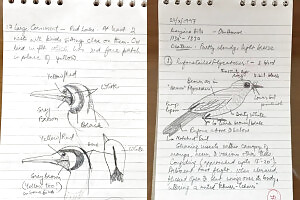
views
Gandhinagar: India's birds are not in the pink of health. A pioneering citizen science report that assessed the status of 867 birds said that of the 261 species for which long-term trends could be determined, 52% have declined since the year 2000. For 146 species, current trends were available and 80% of them are declining.
The report, 'State of India's Birds' (SoIB), is a massive effort of over 20 non-governmental and governmental organisations and most importantly, thousands of birders.
The assessment is the first attempt to fill a vacuum on deficiency of data on hundreds of bird species. It is based on the key indices of change in abundance; both long-term (over 25 years) and short term (over five years) and a measure of distribution in range size.
The Small Minivet, Common Greenshank, Gull-billed Tern and Tawny Eagle are some species that have shown decine. The report also shows how India's peafowl, as well as the eternally popular house sparrow have shown signs of rise and stability.
Although there are no clear long-term scientific studies on the issue, the increase in population of Peafowl is speculated to be linked to the canals and irrigation projects in some states like Rajasthan, and drier climate in others, like Kerala.
The groups that show the greatest decline are raptors, migratory shorebirds, and habitat specialists, among others.
CITIZEN SCIENCE
Over 10 million observations were contributed by 15,500 birdwatchers on the eBird India website. Using the three key indices combined with the Red List of International Union for Conservation of Nature (IUCN), the bird species were categorised as 'low concern', 'moderate concern' and 'high concern'.
The IUCN Red List and other listings categorise wildlife species on the basis of the threats to their habitats and their existence. For instance, the Great Indian Bustard is listed as critically endangered.
The SoIB report concluded that 101 bird species fell in the high concern category, 319 in moderate concern and 442 into low concern category. The decline in high and moderate concern category of birds has largely been recorded over the past five to six years.
“We have attempted to and focussed on the state of the birds and whether their abundance is increasing or decreasing. We have not attempted to investigate the causes of these changes and that requires a separate scientific effort,” said Suhel Quader of the Nature Conservation Foundation, one of the non-governmental organisations leading the project.
Neha Sinha, policy officer and conservationist, Bombay Natural History Society, said, “There is a mismatch between the list of IUCN and the findings of the report. There needs to be a synthesis between the data provided by this report and the data of IUCN. Preferably we should have a national and regional list of our own.”
METHODS
For the period before digital technology arrived, the assessment relied on old notebooks of long time birders. These notebooks not only contain jottings and checklists of birds sighted but also in some cases complete sketches of the birds sighted.

Photo credit: Aasheesh Pittie (Hyderabad)
Data between 1960 and 2000 was crunched into one category due to large gaps and was categorised seperately for the period after 2000. Birdwatchers uploaded their observations to eBird in the form of checklists, which may or may not contain photos and are also marked either complete or incomplete.
“A complete checklist is a list of all species observed during the period of birding, and therefore implicitly includes information about which species were absent (or, more accurately, undetected). Using this, it is possible to calculate an index of abundance, termed ‘frequency of reporting’ for any species,” the report stated.
Ebird has over 150 volunteers or editors who verify the data. Besides, former director of BNHS and veteran ornithologist Asad Rahmani, Carol Inskipp of Himalayan Nature, Chris Bowden of Royal Society for the Protection of Birds, BirdLie International and the Cornell Lab of Ornithology were the independent reviewers of the report.



















Comments
0 comment